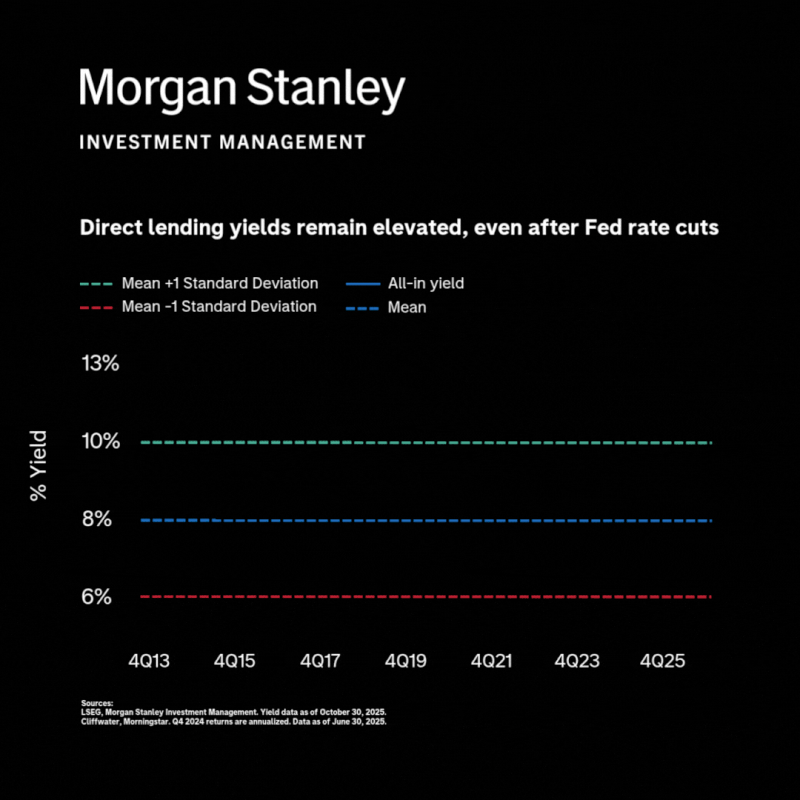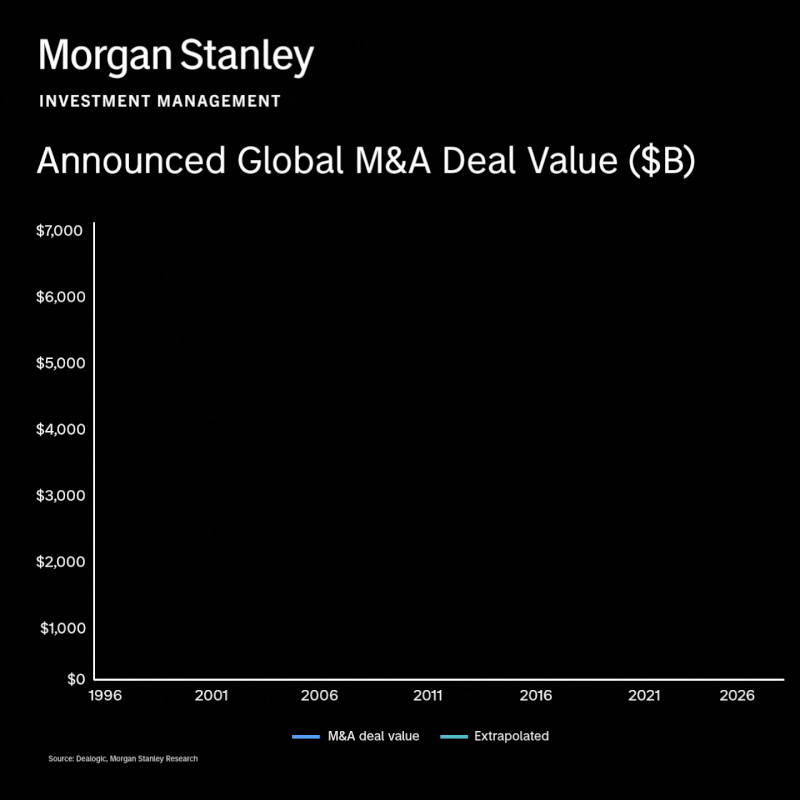About Us
Morgan Stanley Investment Management has been investing in private markets for over 40 years and is widely recognized as a pioneer in allocating across alternatives. We’re uniquely positioned to help financial advisors optimize client outcomes by integrating alternative and traditional investments within a thoughtful portfolio construction framework.
Alternatives On The Rise
With new fund structures making private investments more available to accredited and mass affluent investors, increasing advisor education and knowledge on private market investing has become essential.
Introductory Videos
Alternative investments represent strategies that can deliver different sources of return than traditional stocks and bonds—making them important components of portfolio construction. These foundational videos provide a high-level overview of key segments within the alternatives universe.
Upcoming Classes
Class 4
MSIM’s Approach to Allocating to Private Markets
Tuesday, December 9, 2025 · 11:00am ET
The MSIM’s Approach to Allocating to Private Markets session discusses our proprietary Private Markets Asset Allocation Framework (PMAAF), designed to help investors think about how to allocate their dry powder across private markets and cycles.
Learning Objectives:
- Understand the challenges investors face when building a private markets allocation
- Outline our approach to forming medium term signals across private markets asset classes
- Examples of views expressed in portfolio positioning
CREDITS
1
CFP / CFA / IWI
CE Credit
Class 5
Tax-Managed Alternative Investments
Tuesday, January 27, 2026 · 11:00am ET
The Tax-Managed Alternative Investments session explores integrating Exchange Funds and Long/Short Private Funds into client portfolios to help maximize after-tax outcomes while aligning with clients’ investment objectives.
Learning Objectives:
- Explore the structure, mechanics, and tax benefits of Exchange Funds and how they can be used to diversify concentrated equity positions
- Analyze Long/Short Private Fund strategies with a focus on tax management, including tax deferral, diversification, and tax-alpha creation through tax-loss harvesting
- Evaluate the different applications of these vehicles for different client profiles and portfolio objectives
CREDITS
1
CFP / CFA / IWI
CE Credit
Class 6
Real Estate & Infrastructure
Tuesday, February 10, 2026 · 11:00am ET
The Real Estate and Infrastructure session provides an overview of real asset investing, including real estate, infrastructure, farmland, timberland, and commodities.
Learning Objectives:
- Understand the opportunities presented by private and public investments in real estate, infrastructure, and other real assets
- Differentiate between the risk and return tradeoffs of core, core-plus, value-added, and opportunistic investments
- Discuss the relationship between inflation and the returns to stocks, bonds, and real asset investments
CREDITS
2
CFP / CFA / IWI
CE Credits
Class 7
Deep Dive on Net Lease Investing
Tuesday, March 10, 2026 · 11:00am ET
The Deep Dive on Net Lease Investing session discusses why net lease investing has grown increasingly popular in recent years as an approach to real estate investing.
Learning Objectives:
- Understand the characteristics of net lease investments
- Explain net lease investing strategies and their benefits
- Discuss net lease investments in today’s more volatile environment
CREDITS
1
CFP / CFA / IWI
CE Credit
Class 8
Private Credit
Tuesday, April 7, 2026 · 11:00am ET
The Private Credit session compares investments in floating rate private credit loans and fixed rate public bond markets.
Learning Objectives:
- Understand the differences in risk and return by investing in public and private credit, as well as fixed and floating rate investments
- Discuss the range of private credit investments, including business development companies (BDCs), direct lending, mezzanine, distressed, specialty finance, real asset credit, bridge financing, and special situations
- List the risk, return, and liquidity characteristics of private credit, including the portfolio construction implications of funding allocations from equity, investment grade, and high yield debt
CREDITS
2
CFP / CFA / IWI
CE Credits
Class 9
Hedge Funds
Tuesday, May 5, 2026 · 11:00am ET
The Hedge Funds session defines the portfolio role played by hedge funds, which offer higher long-term returns than investment-grade fixed income while diversifying the portfolio beyond equity and fixed income risks.
Learning Objectives:
- Explain accredited investors, qualified purchasers, and the private placement exemption available to funds offered only to these high-net-worth investors
- Differentiate between Event Driven, Relative Value, Hedged Equity, and Macro and Managed Futures Strategies
- Define convergent and divergent hedge fund strategies and explain their implications for portfolio risk
CREDITS
1
CFP / CFA / IWI
CE Credit
On Demand Classes
Class 3
Evergreen Private Equity: The Future or a Fad?
Now On Demand
The Evergreen Private Equity: The Future or a Fad session discusses why investors have increasingly embraced semi-liquid evergreen funds to access private equity investments.
Learning Objectives:
- Discuss the diversification benefits of a private equity allocation for individual investors
- Understand the difference between semi-liquid evergreen fund and a closed-end drawdown fund
- Explain the different roles private equity strategies play within an evergreen structure
CREDITS
1
CFP / CFA / IWI
CE Credit
Class 2
Private Equity & Venture Capital
Now On Demand
The Private Equity and Venture Capital session discusses how the broad universe of PE and VC backed companies expand the investible universe beyond publicly traded companies.
Learning Objectives:
- Define the lifecycle of a private company and the investors who finance its growth at each stage
- Highlight key performance analysis for PE and VC funds, including internal rate of return (IRR), public market equivalent (PME), and multiple of invested capital (MOIC) metrics
- Discuss the liquidity implications of PE and VC investing, including committed capital, dry powder, capital calls, and exits
CREDITS
2
CFP / CFA / IWI
CE Credits
Class 1
Portfolio Construction & Asset Allocation
Now On Demand
The Portfolio Construction and Asset Allocation session discusses how portfolios can be built to reflect the specific characteristics and needs of each investor.
Learning Objectives:
- Define the characteristics of clients that shape their preferences for investments ranging from aggressive to moderate to conservative risk tolerance
- Discuss investor goals, including risk, return, inflation, taxes, downside protection, and thematic and tactical allocations
- Identify asset allocation methodologies, including capitalization-weighted global portfolios, scenario-based portfolios, risk parity, optimized quantitative portfolios, and the role of alternative investments
CREDITS
2
CFP / CFA / IWI
CE Credits
Featured Insights
-

Private Markets Asset Allocation Framework
This paper introduces our proprietary Private Markets Asset Allocation Framework (PMAAF), designed to help investors think about how to allocate their dry powder across private markets and cycles.
-

Asset Class Introduction: Alternatives
The term “alternative investments” is broad and, in our view, not particularly descriptive or useful. It encompasses all strategies that cannot be accessed through traditional equity and fixed income solutions. These strategies have the potential to address many of the challenges that investors face today—the need for enhanced income, inflation protection, diversification, and stability amid…
-

Asset Class Introduction: Private Equity
Most investors are familiar with traditional investments, which include cash and long-only positions in publicly traded stocks and bonds. Alternative investments are comprised of more complex investments and include private strategies focused on illiquid holdings. Within the private alternatives universe, asset classes include private equity, private credit, real estate and infrastructure. Among these asset classes,…

FEATURED
Morgan Stanley Investment Management Alternatives
We have been committed to managing alternative investment strategies since 1985. Today, we are a leading provider across private equity, private credit, hedge funds, real estate and infrastructure.

















